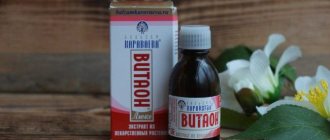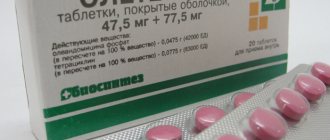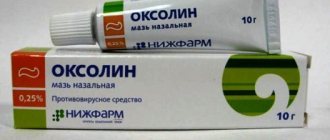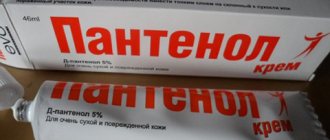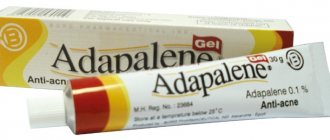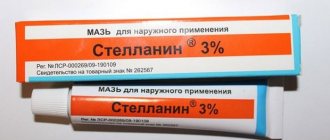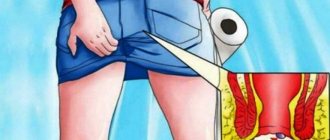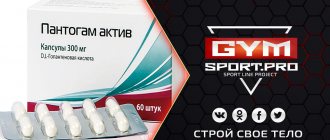Cream Candide B
The drug is designed specifically to combat fungi. The cream very effectively relieves itching and other eczematous symptoms . Candid B is suitable for external use only. The cream can be used to treat the mucous membranes of the skin if there is no increased sensitivity when applying it. The composition of Candid B can be found in the packaging photo.
Compound
The main active ingredient of Candida is clotrimazole. It is obtained from imidazole. Clotrimazole is an active ingredient in many antifungal agents, because. Even mold fungi are sensitive to it. In addition to the imidazole derivative, Candid B contains beclomethasone. This is a local glucocorticoid necessary to reduce itching and other allergic manifestations. The full composition of Candid B cream is shown in the table:
| Components | Concentration in mg |
| Clotrimazole | 10 |
| Beclomethasone | 0,25 |
| White petrolatum jelly, liquid paraffin, cetomacrogol wax, benzyl alcohol, methylparaben, propylparaben, butylated hydroxytoluene, propylene glycol, monosodium phosphate, anhydrous sodium phosphate, purified water. | — |
Release form
Candid B is produced as a cream for topical use. The concentration of the active substance is 1%. The white, homogeneous cream is packaged in 15 g aluminum tubes. The cardboard box contains instructions for use. The drug is used exclusively for external treatment of thrush and mycoses . You cannot take cream instead of tablets against candidiasis.
Pharmacodynamics and pharmacokinetics
The annotation of the instructions states that Candid B is a broad-spectrum drug used for skin infections. The high effectiveness of clotrimazole is due to the fact that it quickly penetrates fungal cells and disrupts the synthesis of ergosterol. This leads to complete dissolution of microorganisms. Fungal membranes will not be able to recover after penetration by clotrimazole.
Yeast-like fungi (genus Candida, Torulopsis glabrata, Rhodotorula), dermatophytes, pathogens of pityriasis versicolor, mold fungi, and pathogens of erythrasma are sensitive to Candida. The cream has an antimicrobial effect against gram-negative and gram-positive bacteria. Absorption of clotrimazole is 3-10% when applied to the mucous membranes of the vagina. The active substance is retained in vaginal secretions for 72 hours.
Candide - indications for use
Doctors prescribe cream for fungal infections. In dermatological practice, Candide is used in the complex treatment of thrush, folliculitis and pyoderma. The drug has a local anti-inflammatory effect, so itching and rash go away very quickly. The following fungal skin infections can be treated with Candid B:
- microsporia of smooth skin;
- athlete's foot;
- athlete's foot inguinal;
- pityriasis versicolor;
- candidiasis caused by Candida albicans.
Indications for use of Candide cream or ointment
When is it recommended to use the drug "Candide"? Instructions for use indicate its effectiveness against the following pathogens:
- yeast-like fungi, including Candida, Rhodotorula, Torulopsis glabrata;
- molds and pathogens of lichen Pityriasis versicolor;
- dermatophytes, including Trichophyton, Epidermophyton and Microsporum;
- streptococci and staphylococci;
- bacteria Gardnerella vaginalis, Trichomonas vaginalis and Bacteroides.
Thanks to such a wide spectrum of activity, the drug “Candide”, the instructions for which contain a fairly wide list of fungi and bacteria, can be used for the following diseases:
- Tinea versicolor.
- Dermatophytosis of the skin of the scalp, legs and body.
- Candidiasis lesions of the skin and nails.
- Candidiasis of the mucous membranes of the genital organs and perineum.
- Erythrasma.
- Candidal paronychia.
Candide B cream - instructions for use
Apply a thin layer of cream to dry and clean skin 2-3 times a day. To prevent relapse of the disease, it is recommended to continue treatment with Candida after the symptoms disappear for 3-4 weeks. The affected area should not be bandaged or covered with a band-aid to avoid the greenhouse effect. The decision about how long Candida treatment will last should be made by a dermatologist. General recommendations for using the cream are as follows:
- For inguinal epidermophytosis, microsporia of smooth skin and candidiasis, the duration of treatment is 2 weeks.
- For athlete's foot, therapy should last 4 weeks.
Treatment with the cream must be continued if the patient is a carrier of chronic fungal diseases. Therapy should not last longer than 4 weeks . If you need to repeat the course of treatment, you must wait 30 days. It is not recommended to self-prescribe Candid B. You must first visit a dermatologist. Only after receiving the results of skin scraping for fungus will the doctor be able to develop an effective treatment plan.
Synonyms of nosological groups
| Category ICD-10 | Synonyms of diseases according to ICD-10 |
| A59.0 Urogenital trichomoniasis | Vaginal trichomoniasis |
| Vaginitis due to Trichomonas | |
| Trichomonas colpitis | |
| Trichomonas genitourinary infection | |
| Trichomonas inflammation of the vagina | |
| Trichomonas inflammation of the genitourinary tract | |
| Trichomonas vaginitis | |
| Trichomonas urinary tract infections | |
| Trichomonas urethritis | |
| Trichomonas balanoposthitis | |
| Trichomonas vaginitis | |
| Trichomonas vulvovaginitis | |
| Trichomonas colpitis | |
| Trichomonas urethritis | |
| Trichomoniasis of the genitourinary system | |
| Urethritis due to Trichomonas | |
| Trichomonas urethritis | |
| B35 Dermatophytosis | Dermatomycosis of the groin area and smooth skin |
| Ringworm Grubi-Saburo | |
| Lichen microsporium | |
| Small-spored ringworm | |
| Mycosis of the skin and nails caused by Trychophyton | |
| Microsporia | |
| Microsporosis | |
| Ringworm | |
| Trichophytosis | |
| Athlete's foot | |
| B35.3 Mycosis of the feet | Foot fungus |
| Dermatophytosis of the feet | |
| Interdigital fungal erosion | |
| Mycosis of the feet | |
| Mycoses of the feet | |
| Mycoses of the feet and large folds | |
| Athlete's foot | |
| B35.4 Mycosis of the trunk | Ringworm of the trunk |
| Dermatomycosis of the trunk | |
| Dermatophytosis of the trunk | |
| Mycosis of the skin | |
| Mycoses of smooth skin of the body | |
| Microsporia of smooth skin | |
| Rubrophytosis of smooth skin | |
| B36.0 Tinea versicolor | Pitirosporum orbiculare |
| Pityriasis versicolor | |
| Pityriasis furfuracea (pityriasis furfuracea) | |
| Ringworm multicolored | |
| Pityriasis versicolor | |
| Tinea versicolor | |
| B36.9 Superficial mycosis, unspecified | Fungal diseases of smooth skin |
| Fungal skin diseases | |
| Fungal infections of smooth body skin | |
| Dermatomycosis | |
| Ringworm in large skin folds | |
| Dermatomycosis of smooth skin | |
| Dermatomycoses | |
| Dermatomycosis of smooth skin | |
| Interdigital fungal erosion | |
| Body skin mycosis | |
| Mycoses complicated by secondary pyoderma | |
| Chronic fungal infections | |
| Athlete's foot | |
| B37.0 Candidal stomatitis | Atrophic candidiasis of the oral cavity |
| Fungal diseases of the oral cavity | |
| Fungal infections of the mouth | |
| Fungal infectious and inflammatory diseases of the oral cavity | |
| Candidiasis of the gastrointestinal tract | |
| Candidiasis of the skin and mucous membranes of the mouth and pharynx | |
| Oral candidiasis | |
| Oral candidiasis | |
| Candidiasis with damage to the skin and mucous membranes | |
| Candidiasis of the oral mucosa | |
| Candidiasis of the mucous membranes | |
| Candidiasis of mucous membranes and skin | |
| Candidiasis of the mucous membranes of the oral cavity and pharynx | |
| Candidiasis of the oral cavity and pharynx | |
| Mucocutaneous candidiasis of the oral cavity | |
| Mycotic jam | |
| Oral thrush | |
| Oropharyngeal candidiasis | |
| Oropharyngeal candidiasis | |
| Chronic atrophic candidiasis of the oral cavity | |
| Chronic candidiasis of the mucous membranes | |
| B37.2 Candidiasis of the skin and nails | Fungal paronychia |
| Fungal eczema | |
| Fungal dermatoses | |
| Fungal diseases of smooth skin | |
| Fungal infections of smooth skin | |
| Fungal infections of smooth body skin | |
| Fungal nail infections | |
| Yeast skin infection | |
| Skin candidiasis | |
| Candidiasis of the skin and mucous membranes of the mouth and pharynx | |
| Candidiasis of the skin of the nail folds | |
| Candidiasis of the nail folds | |
| Nail candidiasis | |
| Candidiasis with damage to the skin and mucous membranes | |
| Candidiasis of mucous membranes and skin | |
| Candidal paronychia | |
| Candidomycosis of the skin | |
| Skin candida infections | |
| Cutaneous candidiasis | |
| Interdigital fungal erosion | |
| Mycotic dermatitis | |
| Paronychia candidiasis | |
| Superficial form of skin candidiasis | |
| Superficial candidiasis | |
| Superficial nail candidiasis | |
| Superficial mycosis of the skin | |
| Chronic skin candidiasis | |
| B37.3 Candidiasis of the vulva and vagina (N77.1*) | Vaginal candidiasis |
| Vaginal candidiasis | |
| Vulval candidiasis | |
| Vulvovaginal candidiasis | |
| Vulvovaginal candidiasis | |
| Vulvovaginitis candidiasis | |
| Vulvovaginitis mycotic | |
| Fungal vaginitis | |
| Vaginal candidiasis | |
| Candidiasis of internal organs | |
| Genitourinary candidiasis | |
| Candidiasis of the genitourinary organs in women | |
| Candidiasis with damage to the skin and mucous membranes | |
| Candidiasis of the mucous membranes | |
| Candidiasis of mucous membranes and skin | |
| Candidal vaginitis | |
| Candidiasis vulvitis | |
| Vulvovaginal candidiasis | |
| Colpitis of fungal etiology | |
| Vaginal thrush | |
| Moniliasis vulvovaginitis | |
| Acute vaginal candidiasis | |
| Acute mycosis of the vagina | |
| Superficial candidiasis of the genital mucosa | |
| Recurrent vaginal candidiasis | |
| Recurrent vaginal candidiasis | |
| Urogenital candidiasis | |
| Chronic vaginal candidiasis | |
| Chronic candidiasis of the mucous membranes | |
| Chronic recurrent vaginal candidiasis | |
| B37.4 Candidiasis of other urogenital sites | Genital candidiasis |
| Genitourinary candidiasis | |
| Candidiasis of the mucous membranes | |
| Candidal balanitis | |
| Candidiasis balanoposthitis | |
| Candiduria | |
| Superficial candidiasis of the genital mucosa | |
| Urogenital candidiasis | |
| B49 Mycosis, unspecified | Visceral mycosis |
| Deep endemic mycoses | |
| Fungal infection | |
| Fungal skin infections | |
| Fungal skin lesions | |
| Fungal infections of skin folds | |
| Fungal infections of the bronchial mucosa | |
| Fungal infections of the oral mucosa | |
| Fungal infections | |
| Fungal skin infections | |
| Keratomycosis | |
| Cutaneous mycosis | |
| Pulmonary mycosis | |
| Mycosis | |
| Mycoses of the eyes | |
| Mycoses of the gastrointestinal tract | |
| Skin mycoses | |
| Mycoses of large skin folds | |
| Systemic mycoses | |
| Mycoses of mucous membranes | |
| Mycoses with secondary bacterial infection | |
| Mycoses in patients with immunodeficiency | |
| Common mycoses | |
| Systemic mycoses | |
| Tropical mycoses | |
| L08.0 Pyoderma | Atheroma festering |
| Pustular dermatoses | |
| Pustular skin lesions | |
| Purulent allergic dermatopathies | |
| Purulent skin infections | |
| Infected atheroma | |
| Mycoses complicated by secondary pyoderma | |
| Ostiofolliculitis | |
| Pyodermatitis | |
| Pyoderma | |
| Superficial pyoderma | |
| Staphylococcal sycosis | |
| Staphyloderma | |
| Streptoderma | |
| Streptostaphyloderma | |
| Chronic pyoderma | |
| L08.1 Erythrasma | Erythrasma |
| N77.1 Vaginitis, vulvitis and vulvovaginitis in infectious and parasitic diseases classified elsewhere | Fungal vulvovaginitis in girls and virgins |
| Mixed vaginal infection | |
| Mixed vaginitis | |
| Specific vulvovaginitis | |
| Chronic recurrent mycosis of the vagina | |
| Cervicovaginitis |
Doctors often prescribe the drug Candide - the instructions for its use contain information that the medication is an antifungal agent for treating the oral cavity, genitals and skin. The active substance of the composition is clotrimazole, which destroys the cells of bacteria and fungal pathogens, preventing them from multiplying, thereby leading to their death.
| Description | Clotrimazole mg concentration | Compound | Package | |
| Solution | Colorless transparent viscous liquid | 10 per 1 ml | Glycerol, propylene glycol | Dropper bottles 15 ml |
| Powder | Light yellow powder with a characteristic odor | 10 per 1 g | Fragrance, talc, corn starch, colloidal silica | Bottles of 30 g |
| Vaginal gel | Homogeneous white color | 20 per 1 g | Water, cetyl alcohol, chlorocresol, cetyl alcohol, sodium hydroxide, propylene glycol, carbopol, glycerol, cetomacrogol emulsion wax, benzyl alcohol | Aluminum tubes 30 g with applicator |
| Cream | White uniform | 10 per 1 g | Water, propylene glycol, sodium hydrogen phosphate, white petrolatum, sodium dihydrogen phosphate dihydrate, liquid paraffin, butylated hydroxytoluene, cetomacrogol emulsion wax, propyl and methyl parahydroxybenzoate, benzyl alcohol | Aluminum tubes 20 g |
| Vaginal tablets | Oval white, truncated, biconvex, without shell | 100 or 500 per 1 piece. | Talc, adipic acid, propyl and methyl parahydroxybenzoate, corn starch, povidone, colloidal silicon dioxide, sodium carboxymethyl starch, lactose monohydrate, sodium bicarbonate, magnesium stearate | Packs of 1 or 6 pcs., with applicator |
The entire line of drugs refers to antifungal agents with a wide spectrum of action for topical use. The active substance of the composition is clotrimazole, an imidazole derivative. Its antimycotic effect is associated with disruption of the synthesis of ergosterol, which is part of the cell membrane of the fungus. The component causes a change in tissue structure and leads to lysis (dissolution) of the fungal cell. In low concentrations it acts as a fungistatic, in high concentrations it acts as a fungicide.
At fungicidal concentrations, the drug interacts with mitochondrial enzymes working as peroxidase, which increases the concentration of hydrogen peroxide to a toxic level. Yeast-like fungi Candida, dermatophytes, Rhodotorula, Torulopsis glabrata, molds, Pityriasis versicolor (lichen versicolor) and erythrasma are sensitive to the active substance. The drug destroys gram-positive microorganisms, staphylococci, streptococci, gram-negative Bacteroides, Gardnerella vaginalis, Trichomonas vaginalis.
When applied topically, the absorption of clotrimazole is negligible, so the systemic effect is practically undetectable. When applied externally, the concentration of the active substance in the epidermis is higher than in the subcutaneous tissue and dermis. With intravaginal administration of gel or tablets, the absorption of clotrimazole is up to 10% of the dose, the concentration remains for up to 72 hours. In the liver, the substance is metabolized to inactive metabolites.
According to the instructions for use, indications for use are different factors. The annotation states:
- candidal stomatitis of the oral cavity;
- fungal skin infections;
- erosion between the fingers caused by fungi;
- mycoses complicated by secondary infection;
- pityriasis versicolor;
- erythrasma;
- candidal vulvovaginitis, paronychia, balanitis, thrush;
- trichomoniasis;
- genital superinfections;
- dermatophytosis of the scalp, face, body, legs;
- onychomycosis (nail fungus);
- candidiasis of the skin, anorectal area, external genitalia;
- fungal diaper dermatitis;
- dermatomycosis;
- sanitation before childbirth of the birth canal.
special instructions
Primary and secondary infections caused by gram-negative bacteria are maintained in warm, moist conditions, including occlusive dressings. Therefore, the affected area is cleaned with soap before applying the cream. The drug should not come into contact with the eyes and mucous membranes. This may lead to an allergic reaction. When treating Candida, patients should follow the following instructions:
- If infection develops or spreads, discontinue the cream and begin antimicrobial therapy.
- Apply the product to a small area of skin and do not use occlusive dressings. Violation of this rule may provoke systemic absorption of beclomethasone.
- The duration of therapy should not exceed 1 month, because Clotrimazole and beclomethasone suppress adrenal function.
Active substance and pharmacological properties
The active substance that helps cope with fungal infections in different places on the human body is clotrimazole.
In a tube weighing 20 g, Candide is sold by the pharmacy chain in the form of a white cream of uniform texture. Each gram of cream contains 10 mg of clotrimazole. The cream also contains: petroleum jelly, paraffin, emulsion wax, propylrabene, alcohol, methylparaben, butylated hydroxytoluene, sodium dihydrogen phosphate and water.
Important! Analogs of this drug are called Canesten, Triderm, Clotrimazole, Candibene.
The pharmacological property of the drug is to destroy the cell structure of different types of fungi, thereby destroying the fungi themselves. Among the infections that Candida cream can cope with, the instructions for use (by the way, the price for it is affordable) names the following lesions of various types of fungi of the skin and mucous membranes:
- Mycoses (feet, nails, skin folds)
- Microsporia
- Skin candidiasis
- Candidal parachinia
- Candidal balanitis
- Dermatophya (legs, head and other parts of the body)
- Infections with yeast and mold fungi
- Dermatoses of newborns, diaper dermatitis
- Candidiasis (thrush) of the genital organs
- Erythrasma
- Pityriasis versicolor and cauliflower
The price of the drug may vary depending on the patient’s place of residence and the manufacturer, and averages 250 rubles. A beclamethasone-enhanced version of the drug, Candide B, costs from 450 rubles. It is able to cope with mycoses complicated by additional manifestations, because it has anti-inflammatory, antiallergic properties, and reduces the feeling of itching.
In childhood
According to the instructions, patients under 16 years of age should be prescribed Candide by a doctor. If burning, itching or other skin reactions occur, wash off the cream. It is strictly forbidden to apply cream and additionally use occlusive dressings. This will lead to the penetration of beclomethasone into the blood and inhibition of the function of the adrenal cortex in children.
Pharmacological action
The drug Candide, according to the instructions for use, is used only externally. The active substance Clotrimazole accumulates in therapeutic doses in the cells of the skin, nails and mucous membranes. It has antibacterial, antiprotozoal, trichomonacid properties.
In doses recommended by the instructions, the drug has a fungistatic and fungicidal effect. Reacting with cellular enzymes, it forms high concentration hydrogen peroxide. This destroys fungal cells and many types of pathogenic bacteria. Among them are Trichomonas vaginalis.
When treated with vaginal tablets, it is partially absorbed into the blood. Metabolized and excreted by the liver in an inactive form with bile.
The use of Candida drops according to the instructions is effective in the treatment of nail fungus and candidiasis of the oral mucosa in children and adults.
Contraindications
The drug is not prescribed to allergy sufferers . The overall effect of clotrimazole on the skin is very insignificant, so there are few contraindications to its use. In reviews, some patients treated herpes simplex with Candida. This cannot be done. In case of hypersensitivity to certain components, the cream is not prescribed. Absolute contraindications for use:
- skin tumors;
- breastfeeding period;
- skin manifestations of syphilis;
- trophic ulcers resulting from chronic venous insufficiency;
- problems with liver metabolism;
- post-vaccination skin reactions.
During pregnancy and lactation
The use of the drug during pregnancy or lactation is permitted in cases where the expected benefit to the mother outweighs the risk to the fetus or infant.
There is no clinically established data that the use of Candide medication topically during pregnancy, as well as during breastfeeding, negatively affects the health of the woman or the unborn child. But it is important that the decision to use the drug during the second and third trimester of pregnancy, as well as during lactation, is made by a doctor.
Do not apply the product to the mammary glands during lactation.
During pregnancy and breastfeeding, the instructions allow the use of the medication only if the benefit to the mother exceeds the risk to the fetus or newborn. Intravaginal forms of drugs are contraindicated in the first trimester of pregnancy. According to experimental data, high doses of clotrimazole cause embryotoxic effects. It is not known whether the active substance is excreted in breast milk.
External use of the drug Candide B, cream, in pregnant women is allowed in cases where the expected benefit to the mother outweighs the risk to the fetus. In such cases, the use of the drug should be short-term and limited to small areas of the skin.
It is not known whether the drug passes into mother's milk, therefore, during breastfeeding, the use of the drug Candide B is possible only under strict indications, and it should not be applied to the skin of the mammary gland before feeding.
Side effects
In some reviews, patients say that after applying the cream there was severe itching. This reaction indicates individual intolerance to Candida. In addition to itching, allergy sufferers may experience a burning sensation and slight tingling at the site of application of the cream. As with the use of other glucocorticoids, patients may experience symptoms of individual intolerance to the drug:
- skin atrophy;
- acne-like changes;
- hyperpigmentation/hypopigmentation of the skin;
- telangiectasia;
- secondary skin infections;
- hypertrichosis.
Directions for use and dosage
- The Candida solution is applied to the affected areas of the skin twice a day . For dermatomycosis, at least 28 days. Pityriasis versicolor can be cured within 7 to 21 days. First, the skin must be washed with soap and thoroughly dried with a towel. If the disease is localized on the legs, after the symptoms disappear, treatment must be continued for 14 days in order to avoid relapse of the disease. Candide in the form of a solution is recommended for use in cases of extensive fungal infection of the scalp;
- The cream is rubbed into the affected areas . Treatment is continued for 14 to 28 days;
- The powder is applied to a previously washed area of skin with soap..
Analogs
The closest analogue of Candida is Clotrimazole . It can be purchased in the form of ointment, suppositories and gel. The average price of the product is 150 rubles. This antifungal drug is often used in the treatment of candidiasis. Another Candida substitute is Canison . The active substance of this drug is clotrimazole. The following Candid B analogues can be purchased at the pharmacy:
- Kanesten;
- Candiderm;
- Rederm.
Composition and analogues
Candide is a synthetic broad-spectrum antifungal drug. Despite its name, it acts not only against fungi of the genus Candida, but also against some others. The main active ingredient of the drug is clotrimazole, depending on the dosage form, the composition may contain certain auxiliary components. Treatment of lesions on both mucous membranes and skin is equally effective.
The drug Candide in any dosage form in Russia can be found mainly from India. This is explained by the fact that such drugs are relatively inexpensive and of high quality. The closest analogues of the drug are Nizoral, Candibene, Candibiotic, etc.
Price for Candide B
The average cost of the product is 439 rubles. The price of Candiderm is slightly higher. It can be purchased for 445 rubles. Kanizon is considered the most budget-friendly. Its average price is 75 rubles. The cost of antifungal drugs depends not only on the form of release, but also on the pharmacological company involved in their production. The table shows the price of Candida and its closest analogues:
| Product name | Price in rubles |
| Candid B | 439 |
| Clotrimazole | 129 |
| Kanizon | 75 |
| Kanesten | 168 |
| Candiderm | 445 |
| Rederm | 158 |
Duration of treatment
Candide cream instructions for use give a complete picture of this medicine and its therapeutic effect. The timing of treatment directly depends on the severity of the disease, the location of the infected area, the patient’s susceptibility to the prescribed therapy and the type of fungi that affected him. The course of treatment usually lasts from one to four weeks.
Side effects
- Skin rashes in the form of hives, redness, itching, swelling;
- The appearance of blisters and peeling;
- Unpleasant sensations in the genitals in the form of pain and/or burning.
Reviews
Anna, 36 years old
After visiting the pool, foot fungus appeared. The disease was accompanied by terrible itching and peeling of the skin. I purchased Candid B at the pharmacy by accident, because... I have run out of the cream that I buy in such situations. The product helped immediately. After 15 minutes, the itching went away, and the peeling disappeared completely after 3 days. I will continue treating the fungus with Candida.
Alexandra, 27 years old
For a long time I suffered from thrush caused by dysbacteriosis. The doctor prescribed Candid B for the treatment of candidiasis. While I was using the cream, white discharge did not appear, but as soon as I stopped, it all started again. In my case, bowel medications helped me finally cope with the disease. There were no side effects from the cream.
Evgeniy, 34 years old
I purchased Candid B instead of the antifungal solution. I applied the cream to my cracked little finger 3 times a day for a month. I didn’t notice any positive changes at all. I believe that this broad-spectrum remedy will only help against mild manifestations of dermatophytosis, but for advanced diseases, Candide is useless.
Release form
Solution for topical use, 1%. 15 ml in a PE bottle with a built-in PE dropper stopper, screwed with a plastic cap. 1 fl. placed in a cardboard pack.
The medicine has several forms of release. Currently produced are Candide gel 2%, cream for external use 1%, powder for external use 1%, solution for topical use 1%, as well as vaginal tablets (suppositories) Candide.
- The cream is a homogeneous white substance, contained in a 20 g aluminum tube.
- A solution for topical use, transparent, colorless, has a viscous consistency. The bottle contains 15 g of product.
- Powder for external use (powder) is contained in a 30 g plastic bottle.
Clotrimazole is the main component of Candida ointment. This component has an extended spectrum of action. It stops the development of the fungus and also destroys the membrane of the pathogen cells. This allows you to quickly cope with pathogenic fungal infections. Clotrimazole also has an antibacterial effect. 1 gram of ointment contains 10 mg of active substance.
In addition to clotrimazole, the composition includes paraffin, petroleum jelly and other additional components that ensure the creation of a creamy emulsion. The cream is produced in an aluminum tube with a volume of 20 grams. The product is a homogeneous white substance.
Candide B is an enhanced version of the drug. In addition to clotrimazole, it contains beclomethasone. Thanks to this ingredient, the cream has anti-inflammatory and antihistamine properties. Candide B is used for complicated fungal infections characterized by additional symptoms.
Some people mistakenly believe that there is a certain Candide D. But in fact, there is no such type of cream. It comes in two forms, described above.
Cream for external use. In aluminum tubes, 15 g. One tube in a cardboard box.

